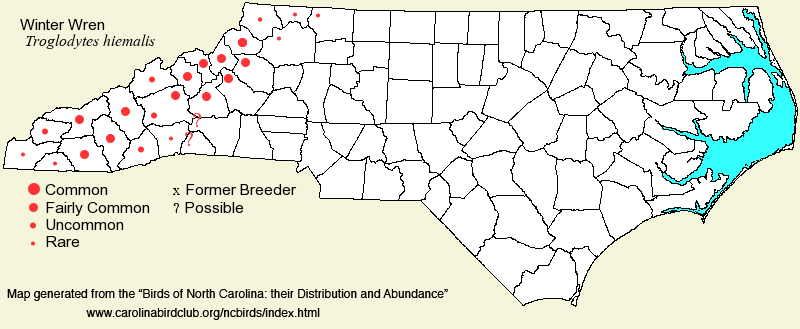 |  |
|
Winter Wren - Troglodytes hiemalis TROGLODYTIDAE Members: | Search Common: Search Scientific: |
|
|
|||||||
| General Comments | The Winter Wren underwent a taxonomic change in 2010, when the American Ornithologists' Union split the former continent-wide species into two species. The Western forms are now the Pacific Wren, and the birds nesting in the eastern half of the continent remain the Winter Wren, but with a new scientific name (formerly Troglodytes troglodytes, and now T. hiemalis). In the East, they nest down the spine of the Appalachian Mountains, and thus in North Carolina are confined to our mountains in summer. It occurs statewide in other seasons; thus, it is found in all 100 counties in winter. This tiny ball of brown feathers can be hard to spot, at least in summer; their very long and beautiful song is often heard, but tracking down the bird can be difficult. Breeding habitats are in cool habitats -- spruce-fir forests or where mixed with hardwoods, hemlock (formerly) forests, and cove forests with White Pine or dense rhododendron stands. The breeding population appears to have expanded down-slope from the higher mountains over the last few decades; however, record-keeping 50 or more years ago was not thorough enough to know for certain that these middle elevations were devoid of Winter Wrens in summer. In winter, the birds require dense cover within 3 feet of the ground, in a variety of forest types. They stay close to brush piles, thickets, stream banks, and fallen trees at this season. During and after severe winter weather, which kills a number of these birds, the species is often uncommon and can be hard to find. | ||||||
| Breeding Status | Breeder | ||||||
| NC BRC List | Definitive | ||||||
| State Status | W | ||||||
| U.S. Status | |||||||
| State Rank | S3B,S5N | ||||||
| Global Rank | G5 | ||||||
| Coastal Plain | Winter resident. Fairly common to common in the Tidewater zone and near the northern and central coast; uncommon to fairly common along the southern coast. Farther inland, fairly common, being slightly less numerous toward the south. Mainly early or mid-Oct to early Apr. Peak counts: | ||||||
| Piedmont | Winter resident. Fairly common over most of the region; less common toward the foothills, where it can be uncommon. Mainly mid-Oct to late Mar or early Apr. Peak counts: | ||||||
| Mountains | Summer resident in parts of the region, and winter resident regionwide. In summer, fairly common above 4,000 feet, and uncommon and local down to about 3,000 feet. Can be common in some spruce-fir stands at the highest elevations. In winter, generally uncommon across the region, and absent at the higher elevations. Peak counts: perhaps a state high count for a single party was 39 along the Wilson Boundary Trail between Stepps Gap and Balsam Gap (Mitchell) on 10 Jun 2020. | ||||||
| Finding Tips |
In summer, you should not have trouble hearing the species in most spruce-fir stands, though they can be difficult to actually see. In winter, they are not hard to find in many forested areas, such as on the Pamlimarle Peninsula. *** | ||||||
| Attribution | LeGrand[2023-03-27], LeGrand[2020-10-21], LeGrand[2018-02-02] | ||||||
| NC Map Map depicts all counties with a report (transient or resident) for the species. | Click on county for list of all known species. |
| NC Breeding Season Map Map depicts assumed breeding season abundance for the species. |  |